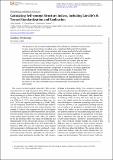Files in this item
Calculating self-concept structure indices, including Linville’s H : toward standardization and replication
Item metadata
| dc.contributor.author | Smyth, Lillian | |
| dc.contributor.author | Banas, Kasia | |
| dc.contributor.author | Mavor, Kenneth I. | |
| dc.date.accessioned | 2022-11-10T10:30:23Z | |
| dc.date.available | 2022-11-10T10:30:23Z | |
| dc.date.issued | 2022-10-12 | |
| dc.identifier | 282093580 | |
| dc.identifier | 08f29361-6472-4cf8-a7a1-26b0796e0ff5 | |
| dc.identifier | 85170289513 | |
| dc.identifier.citation | Smyth , L , Banas , K & Mavor , K I 2022 , ' Calculating self-concept structure indices, including Linville’s H : toward standardization and replication ' , Collabra: Psychology , vol. 8 , no. 1 , 38597 . https://doi.org/10.1525/collabra.38597 | en |
| dc.identifier.issn | 2474-7394 | |
| dc.identifier.other | Jisc: 713354 | |
| dc.identifier.other | ORCID: /0000-0002-3160-3889/work/122720404 | |
| dc.identifier.uri | https://hdl.handle.net/10023/26357 | |
| dc.description.abstract | The structure of the self and its relationship with wellbeing are of interest to researchers in many areas of psychology, including social, clinical and differential. Psychologists seeking to calculate the self-concept structure indices associated with the self-complexity framework have long been faced with a computation bottleneck. The complex formulae, variable approaches and lack of availability of ready-to-use programs that allow streamlined calculation of dimensionality (Linville’s H), complexity (Sakaki’s SC), overlap (OL) and compartmentalisation (Shower’s Phi) means that the research area has been limited in both research speed and participation. The low volume of studies and the computational disincentive for replications have led to a situation where the evidence on self-complexity and related constructs is equivocal. In this article, we discuss approaches to calculating self-concept structure, providing a practical guide for researchers who would like to implement the published formulas or use existing computational tools, made available by the authors. This tutorial will allow both efficiency and broader access for researchers seeking to examine constructs related to self-concept structure. We hope that these contributions might foster a new wave of data collection in this area, allowing for clarity on the utility and implications of dimensionality and complexity in the self-concept. | |
| dc.format.extent | 13 | |
| dc.format.extent | 573362 | |
| dc.language.iso | eng | |
| dc.relation.ispartof | Collabra: Psychology | en |
| dc.subject | Self-complexity | en |
| dc.subject | Self-concept | en |
| dc.subject | Tutorial | en |
| dc.subject | BF Psychology | en |
| dc.subject | DAS | en |
| dc.subject | MCC | en |
| dc.subject.lcc | BF | en |
| dc.title | Calculating self-concept structure indices, including Linville’s H : toward standardization and replication | en |
| dc.type | Journal article | en |
| dc.contributor.institution | University of St Andrews. School of Psychology and Neuroscience | en |
| dc.identifier.doi | https://doi.org/10.1525/collabra.38597 | |
| dc.description.status | Peer reviewed | en |
This item appears in the following Collection(s)
Items in the St Andrews Research Repository are protected by copyright, with all rights reserved, unless otherwise indicated.

